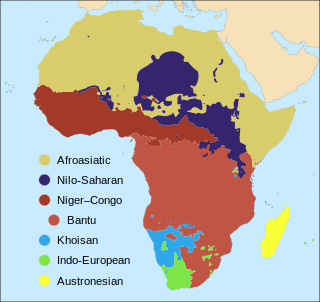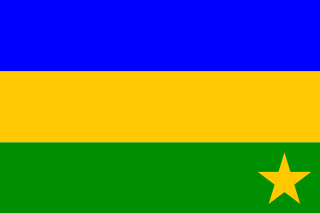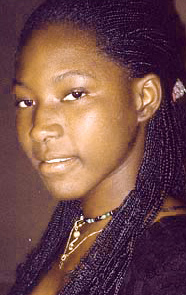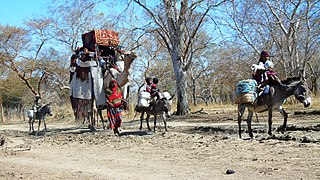Related Research Articles

Sudan, officially the Republic of the Sudan, is a country in Northeast Africa. It borders the Central African Republic to the southwest, Chad to the west, Egypt to the north, Eritrea to the northeast, Ethiopia to the southeast, Libya to the northwest, South Sudan to the south, and the Red Sea. It has a population of 45.7 million people as of 2022 and occupies 1,886,068 square kilometres, making it Africa's third-largest country by area and the third-largest by area in the Arab League. It was the largest country by area in Africa and the Arab League until the secession of South Sudan in 2011; since then both titles have been held by Algeria. Its capital city is Khartoum, and its most populous city is Omdurman.

The number of languages natively spoken in Africa is variously estimated at between 1,250 and 2,100, and by some counts at over 3,000. Nigeria alone has over 500 languages, one of the greatest concentrations of linguistic diversity in the world. The languages of Africa belong to many distinct language families, among which the largest are:

The Arab world, formally the Arab homeland, also known as the Arab nation, the Arabsphere, or the Arab states, comprises a vast group of countries, mainly located in Western Asia and Northern Africa. While the majority of people in the Arab world are ethnically Arab, there are also significant populations of other ethnic groups such as Berbers, Kurds, Somalis and Nubians, among other groups. Arabic is used as the lingua franca throughout the Arab world.

The culture of the Republic of Djibouti is diverse, due to the nation's Red Sea location at a crossroads of trade and commerce.

The Kanuri people are an African ethnic group living largely in the lands of the former Kanem and Bornu Empires in Niger, Nigeria, Chad, Libya and Cameroon. As well as a diaspora community residing in Sudan. Those generally termed Kanuri include several subgroups and dialect groups, some of whom identify as distinct from the Kanuri. Most trace their origins to ruling lineages of the medieval Kanem-Bornu Empire, and its client states or provinces. In contrast to the neighboring Toubou or Zaghawa pastoralists, Kanuri groups have traditionally been sedentary, engaging in farming, fishing the Chad Basin, trade, and salt processing.
The Fur are an ethnic group predominantly inhabiting western Sudan. They are concentrated in the Darfur region, where they are the largest ethnic group. They speak the Fur language, which belongs to the Nilo-Saharan family.
The Masalit are an ethnic group inhabiting western Sudan and eastern Chad. They speak the Masalit language.
The Kujargé language is spoken in seven villages in eastern Chad near Jebel Mirra, and in villages scattered along the lower Wadi Salih and Wadi Azum in Darfur, Sudan. It is estimated to have about 1000 speakers.
The Zaghawa people, also called Beri or Zakhawa, are a Sahelian ethnic group primarily residing in southwestern Libya, northeastern Chad, and western Sudan, including Darfur.

The Sara people are a Central Sudanic ethnic group native to southern Chad, the northwestern areas of the Central African Republic, and the southern border of North Sudan. They speak the Sara languages which are a part of the Central Sudanic language family. They are also the largest ethnic group in Chad.

Chad has two official languages, Arabic and French, and over 120 indigenous languages. A vernacular version of Arabic, Chadian Arabic, is a lingua franca and the language of commerce, spoken by 40–60% of the population. The two official languages have fewer speakers than Chadian Arabic. Standard Arabic is spoken by around 615,000 speakers. French is widely spoken in the main cities such as N'Djamena and by most men in the south of the country. Most schooling is in French. The language with the most first-language speakers is probably Ngambay, with around one million speakers.

The Bishari are an ethnic group who live in parts of Northeast Africa. They are one of the major divisions of the Beja people. Apart from local dialects of Arabic, the Bishari speak the Beja language, which belongs to the Afroasiatic family of the Cushitic branch.
The Fongoro, Kole or Gelege are an ethnic group of Sudan and Chad; about 1,000 members of this ethnic group live in the Sila Region of Chad along the Sudanese border. The primary language is Fongoro.
Kimr or Gimr is an ethnic group in West Darfur in Sudan and Chad. They speak Gimr, a dialect of Tama, a Nilo-Saharan language. The population of this ethnicity possibly is below 10,000. One 1996 source puts the population at over 50,000.
The Maba or Bargo people are a Sunni Muslim ethnic group found primarily in the mountains of Wadai region in eastern Chad and southern Sudan. Their population is estimated to be about 542,000. Other estimates place the total number of Bargo people in Sudan to be about 25,000.
Tama are a non-Arab, African ethnic group of people who live in eastern Chad and western Sudan. They speak Tama, a Nilo-Saharan language. The population is 200,000–300,000 people and they practice Islam. Many Tama are subsistence farmers who live in permanent settlements and some raise livestock. In the civil war in Chad (2005–2010) the Tama were involved in ethnic conflicts with the Zaghawa tribe.
The Daju people are a group of seven distinct ethnicities speaking related languages living on both sides of the Chad-Sudan border and in the Nuba Mountains. Separated by distance and speaking different languages, at present, they generally have little cultural affinity to each other.

The Hausa are a native ethnic group in West Africa. They speak the Hausa language, which is the second most spoken language after Arabic in the Afro-Asiatic language family. The Hausa are a culturally homogeneous people based primarily in the Sahelian and the sparse savanna areas of southern Niger and northern Nigeria respectively, numbering around 86 million people, with significant populations in Benin, Cameroon, Ivory Coast, Chad, Central African Republic, Togo, Ghana, as well as smaller populations in Sudan, Eritrea, Equatorial Guinea, Gabon, Senegal and the Gambia.

The population of Chad has numerous ethnic groups. SIL Ethnologue reports more than 130 distinct languages spoken in Chad.
The Tunjur kingdom was a Sahelian precolonial kingdom in Africa between the 15th and early 17th centuries.
References
- ↑ "Sinyar language". Ethnologue . Retrieved 27 September 2019.
- ↑ "Sinyar language". Ethnologue . Retrieved 27 September 2019.
- 1 2 3 Olson, James Stuart (1996). The Peoples of Africa: An Ethnohistorical Dictionary. Greenwood Publishing Group. p. 526. ISBN 978-0-313-27918-8.
- 1 2 3 Weekes, Richard (1985). Muslim peoples : a world ethnographic survey. Greenwood Press. pp. 690–694. ISBN 978-0-86172-038-5.